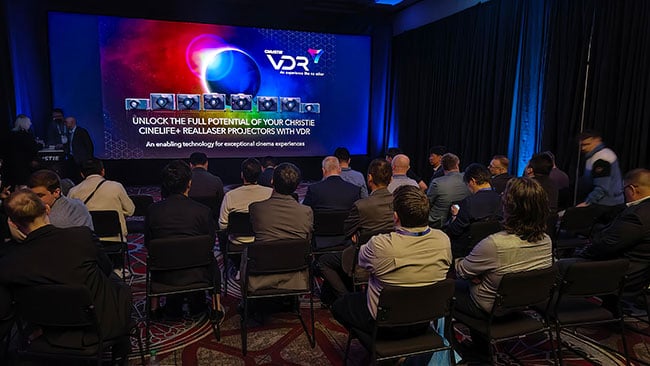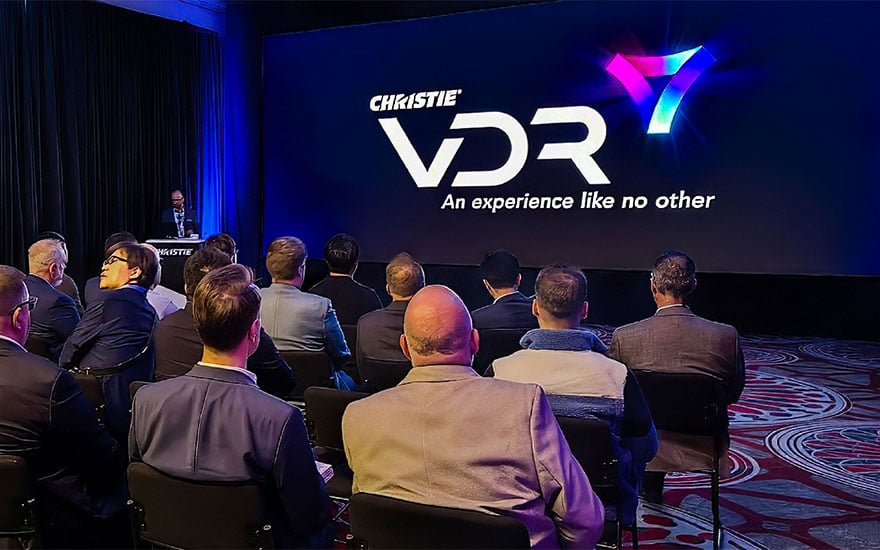Learn more about VDR, the new cinema projector technology we showcased at CinemaCon
Key takeaways:
- VDR is a patented Christie cinema projector technology
- It reduces laser power consumption by 32%, increasing laser lifetime by 50-70%
- It increases the detail in dark scenes with deeper blacks
- VDR achieves up to 60,000:1 sequential contrast when combined with a UHC (Ultra High Contrast) lens and HDR content.
For over six decades, we’ve been at the forefront of cinema innovation. Our deep understanding of the industry, from the transition to digital from 35 mm film to the introduction of the Virtual Print Fee, has earned us a few Academy Awards® and demonstrated our passion for delivering the best on-screen image for moviegoers to enjoy.
We know the cinema business is always evolving, and we’re committed to working alongside exhibitors to develop cinema solutions that deliver the exceptional experience moviegoers expect. And at this year’s CinemaCon, we previewed VDR, our newest technology that helps exhibitors achieve substantial energy savings, longer laser life, and a higher contrast ratio.
What’s VDR? Let’s take a look.
It’s an enabling technology that optimizes your cinema.
You may be asking yourself, “What does that mean?”
VDR is a patented technology that’s comprised of a software update for our CineLife+ Series projectors with Real|Laser illumination. This technological innovation enables the projector to analyze every incoming video frame in real-time, and compute and modify the output laser power as needed on every video frame. Content is optimized for contrast, black-level detail, and power savings, all while retaining the original creative intent.
During the demonstration at CinemaCon, we achieved a 32% reduction in laser power consumption, which will lead to a 50-70% increase in laser lifetime.
As a result, images are better, not just manipulated to look that way. The technology requires no special mastering and will work with any content – VDR delivers a superior image with standard content workflows – whether it’s standard or HDR-derived cinema content (and anything in between).
VDR increases the detail in dark scenes with deeper blacks and achieves up to 60,000:1 sequential contrast when combined with a UHC (Ultra High Contrast) lens and HDR content. During the demonstration at CinemaCon, we achieved a 32% reduction in laser power consumption, which will lead to a 50-70% increase in laser lifetime.
For example, if an exhibitor were to install a projector operating at 70-80% laser power, they can expect approximately 50,000 hours of constant brightness before the laser brightness begins to drop. That’s about 10 years of operation in a busy cinema. With VDR, a 50% laser life improvement would extend this to 75,000 hours or 15 years, so the laser devices should easily last the life of the projector.
Why did we develop VDR?
We created VDR to address a few challenges that exhibitors face: the ability to offer a premium yet economical and differentiated experience for their guests, showing the latest DCI-compliant SDR and HDR formats available on screens large and small.
We understand that the total cost of ownership of a projector is an important consideration for exhibitors. That's why we designed VDR to be compatible with our CineLife+ Series of Real|Laser cinema projectors, including those already in the field.
You don’t need a new projector to take advantage of the improved contrast, image quality, and laser lifespan that VDR offers. If exhibitors already use Christie CineLife+ Series of Real|Laser cinema projectors, it’s a relatively inexpensive software upgrade and license fee to achieve this performance.
VDR at CinemaCon

We previewed VDR at CinemaCon, demonstrating its vividly dramatic capabilities with standard DCI content at 2X contrast and HDR content with 10X contrast of 60,000:1. We’ll continue to showcase VDR at tradeshows around the world, and we expect to release it by the end of 2025.


